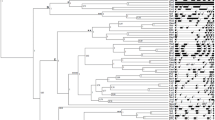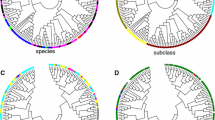Abstract
Some pathogenesis-related proteins (PR proteins) are subject to positive selection, while others are under negative selection. Here, we report the patterns of molecular evolution in thaumatin-like protein (TLP, PR5 protein) genes of Populus trichocarpa. Signs of positive selection were found in 20 out of 55 Populus TLPs using the likelihood ratio test and ML-based Bayesian methods. Due to the connection between the acidic cleft and the antifungal activity, the secondary structure and three-dimensional structure analyses predicted antifungal activity β-1,3-glucanase activities in these TLPs. Moreover, the coincidence with variable basic sites in the acidic cleft and positively selected sites suggested that fungal diseases may have been the main environmental stress that drove rapid adaptive evolution in Populus.



Similar content being viewed by others
Abbreviations
- PR proteins:
-
Pathogenesis-related proteins
- TLPs:
-
Thaumatin-like proteins
- ML:
-
Maximum likelihood
- JTT:
-
Jones–Taylor–Thornton
- AIC:
-
Akaike information criterion
- LRT:
-
Likelihood ratio test
- BEB:
-
Bayes empirical Bayesian
- NEB:
-
Naive empirical Bayes
- ABA:
-
Abscisic acid
- SA:
-
Salicylate acid
- JA:
-
Jasmonic acid
- ET:
-
Ethylene
References
Abad LR, D’Urzo MP, Dong L, Narasimhan ML, Reuveni M, Zhu JK, Niu X, Singh NK, Hasegawa PM, Bressan RA (1996) Antifungal activity of tobacco osmotin has specificity and involves plasma membrane permeabilization. Plant Sci 118:11–23
Abascal F, Zardoya R, Posada D (2005) ProtTest: selection of best-fit models of protein evolution. Bioinformatics 21:2104–2105
Anna B, Sergio A, Mariella T, Christian C, Paolo P (2004) Plant stress proteins of the thaumatin-like family discovered in animals. FEBS Lett 573:3–7
Batalia MA, Monzingo AF, Ernst S, Roberts W, Robertus JD (1996) The crystal structure of the antifungal protein zeamatin, a member of the thaumatin-like, PR-5 protein family. Nat Struct Biol 3:19–23
Bergelson J, Kreitman M, Stahl EA, Tian D (2001) Evolutionary dynamics of plant R-genes. Science 292:2281–2285
Bishop JG, Dean AM, Mitchell-Olds T (2000) Rapid evolution in plant chitinases: molecular targets of selection in plant-pathogen coevolution. Proc Natl Acad Sci USA 97:5322–5327
Borregaard N, Elsbach P, Ganz T, Garred P, Svejgaard A (2000) Innate immunity: from plants to humans. Trends Immunol Today 21:68–70
Chen WP, Chen PD, Liu DJ, Kynast R, Friebe B, Velazhahan R, Muthukrishnan S, Gill BS (1999) Development of wheat scab symptoms is delayed in transgenic wheat plants that constitutively express a rice thaumatin-like protein gene. Theor Appl Genet 99:755–760
DeLano WL (2002) The PyMol molecular graphics system.0.99. DeLano Scientific, San Carlos
Felsenstein J (2004) PHYLIP (Phylogeny Inference Package) version 3.65. Distributed by the author. Department of Genetics, University of Washington, Seattle
Ford MJ (2001) Molecular evolution of transferrin: evidence for positive selection in Salmonids. Mol Biol Evol 18:639–647
Ghosh R, Chakrabarti C (2008) Crystal structure analysis of NP24-I: a thaumatin-like protein. Planta 228:883–890
Grenier J, Potvin C, Trudel J, Asselin A (1999) Some thaumatin-like proteins hydrolyze polymeric β-1, 3-glucans. Plant J 19:473–480
Guex N, Peitsch MC (1997) SWISS-MODEL and the Swiss-PdbViewer: an environment for comparative protein modeling. Electrophoresis 18:2714–2723
Kitajima S, Sato F (1999) Plant pathogenesis-related proteins: molecular mechanisms of gene expression and protein function. J Biochem 125:1–8
Koiwa H, Kato H, Nakatsu T, Oda J, Yamada Y, Sato F (1999) Crystal structure of tobacco PR-5d protein at 1.8 A resolution reveals a conserved acidic cleft structure in antifungal thaumatin-like proteins. J Mol Biol 286:1137–1145
Kunkel BN, Brooks DM (2002) Cross talk between signaling pathways in pathogen defense. Curr Opin Plant Biol 5:325–331
Leone P, Menu-Bouaouiche L, Peumans WJ, Payan F, Barre A, Roussel A, Van Damme EJ, Rougé P (2006) Resolution of the structure of the allergenic and antifungal banana fruit thaumatin-like protein at 1.7-A. Biochimie 88:45–52
McDowell JM, Dhandaydham M, Long TA, Aarts MGM, Goff S, Holub EB, Dang JL (1998) Intragenic recombination and diversifying selection contribute to the evolution of downy mildew resistance at the RPP8 locus of Arabidopsis. Plant Cell 10:1861–1874
Menu-Bouaouiche L, Vriet C, Peumans WJ, Barre A, van Damme EJM, Rougé P (2003) A molecular basis for the endo-beta 1, 3-glucanase activity of the thaumatin-like proteins from edible fruits. Biochimie 85:123–131
Meyers BC, Shen KA, Rohani P, Gaut BS, Michelmore RW (1998) Receptor-like genes in the major resistance locus of lettuce are subject to divergent selection. Plant Cell 10:1833–1846
Min K, Ha SC, Hasegawa PM, Bressan RA, Yun DJ, Kim KK (2004) Crystal structure of osmotin, a plant antifungal protein. Proteins 54:170–173
Mondragón-Palomino M, Meyers BC, Michelmore RW, Gaut BS (2002) Patterns of positive selection in the complete NBS-LRR gene family of Arabidopsis thaliana. Genome Res 12:1305–1315
Newcombe G (1996) The specificity of fungal pathogens of Populus. In: Stettler RF, Bradshaw HD Jr, Heilman PE, Hinckley TM (eds) Biology of Populus and its implications for management and conservation. NRC Research Press, Ottawa, pp 223–246
Osmond RI, Hrmova M, Fontaine F, Imberty A, Fincher GB (2001) Binding interactions between barley thaumatin-like proteins and (1, 3)-beta-D-glucans. Kinetics, specificity, structural analysis and biological implications. Eur J Biochem 268:4190–4199
Piggott N, Ekramoddoullah AKM, Liu JJ, Yu X (2004) Gene cloning of a thaumatin-like (PR-5) protein of western white pine (Pinus monticola D. Don) and expression studies of members of the PR-5 group. Physiol Mol Plant Pathol 64:1–8
Scherer NM, Thompson CE, Freitas LB, Bonatto SL, Salzano FM (2005) Patterns of molecular evolution in pathogenesis-related proteins. Genet Mol Biol 28:645–653
Schwede T, Kopp J, Guex N, Peitsch MC (2003) SWISS-MODEL: an automated protein homology-modeling server. Nucleic Acids Res 31:3381–3385
Shatters RG Jr, Boykin LM, Lapointe SL, Hunter WB, Weathersbee AA III (2006) Phylogenetic and structural relationships of the PR5 gene family reveal an ancient multigene family conserved in plants and select animal taxa. J Mol Evol 63:12–29
Stinzi A, Heitz T, Prasad V, Wiedemann-Merdinoglu S, Kauffmann S, Geoffroy P, Legrand M, Fritig B (1993) Plant ‘pathogenesis-related’ proteins and their role in defense against pathogens. Biochimie 75:687–706
Tamura K, Dudley J, Nei M, Kumar S (2007) MEGA4: molecular evolutionary genetics analysis (MEGA) software version 4.0. Mol Biol Evol 24:1596–1599
Trudel J, Grenier J, Potvin C, Asselin A (1998) Several thaumatin-like proteins bind to β-1, 3-glucans. Plant Physiol 118:1431–1438
Tuskan GA, Difazio S, Jansson S, Bohlmann J, Grigoriev I, Hellsten U, Putnam N, Ralph S, Rombauts S, Salamov A, Schein J, Sterck L, Aerts A, Bhalerao RR, Bhalerao RP, Blaudez D, Boerjan W, Brun A, Brunner A, Busov V, Campbell M, Carlson J, Chalot M, Chapman J, Chen GL, Cooper D, Coutinho PM, Couturier J, Covert S, Cronk Q, Cunningham R, Davis J, Degroeve S, Déjardin A, Depamphilis C, Detter J, Dirks B, Dubchak I, Duplessis S, Ehlting J, Ellis B, Gendler K, Goodstein D, Gribskov M, Grimwood J, Groover A, Gunter L, Hamberger B, Heinze B, Helariutta Y, Henrissat B, Holligan D, Holt R, Huang W, Islam-Faridi N, Jones S, Jones-Rhoades M, Jorgensen R, Joshi C, Kangasjärvi J, Karlsson J, Kelleher C, Kirkpatrick R, Kirst M, Kohler A, Kalluri U, Larimer F, Leebens-Mack J, Leplé JC, Locascio P, Lou Y, Lucas S, Martin F, Montanini B, Napoli C, Nelson DR, Nelson C, Nieminen K, Nilsson O, Pereda V, Peter G, Philippe R, Pilate G, Poliakov A, Razumovskaya J, Richardson P, Rinaldi C, Ritland K, Rouzé P, Ryaboy D, Schmutz J, Schrader J, Segerman B, Shin H, Siddiqui A, Sterky F, Terry A, Tsai CJ, Uberbacher E, Unneberg P, Vahala J, Wall K, Wessler S, Yang G, Yin T, Douglas C, Marra M, Sandberg G, Van de Peer Y, Rokhsar D (2006) The genome of black cottonwood, Populus trichocarpa (Torr. & Gray). Science 313:1596–1604
van Loon LC (1985) Pathogenesis-related proteins. Plant Mol Biol 4:111–116
van Loon LC, Rep M, Pieterse CMJ (2006) Significance of inducible defense-related proteins in infected plants. Annu Rev Phytopathol 44:135–162
Velazhahan R, Datta SK, Muthukrishnan S (1999) The PR-5 family: thaumatin-like proteins in plants. In: Datta SK, Muthukrishnan S (eds) Pathogenesis-related proteins in plants. CRC Press, Boca Raton, pp 107–129
Vigers AJ, Roberts WK, Selitrennikoff CP (1991) A new family of plant antifungal proteins. Mol Plant-Microbe Interact 4:315–323
Wang GL, Ruan DL, Song WY, Sideris S, Chen L, Pi LY, Zhang S, Zhang Z, Fauquet C, Gaut BS, Whalen MC, Ronald PC (1998) Xa21D encodes a receptor-like molecule with a leucine-rich repeat domain that determines race-specific recognition and is subject to adaptive evolution. Plant Cell 10:765–780
Ward ER, Uknes SJ, Wllliams SC, Dincher SS, Wlederhold DL, Alexander DC, Ahl-Goy P, Metraux JP, Ryals JA (1991) Coordinate gene activity in response to agents that induce systemic acquired resistance. Plant Cell 3:1085–1094
Xu Y, Chang PLC, Liu D, Narasimhan ML, Kashchandra GR, Hasegawa PM, Bressan RA (1994) Plant defense genes are synergistically induced by ethylene and methyl jasmonate. Plant Cell 6:1077–1085
Yang Z (2007) PAML 4: Phylogenetic analysis by maximum likelihood. Mol Biol Evol 24:1586–1591
Zechel DL, Withers SG (2001) Dissection of nucleophilic and acid-base catalysis in glycosidases. Curr Opin Chem Biol 5:643–649
Zwickl DJ (2006) Genetic algorithm approaches for the phylogenetic analysis of large biological sequence datasets under the maximum likelihood criterion. Dissertation, The University of Texas at Austin
Acknowledgments
This work was financially supported by National Natural Science Foundation of China (No. 30872048), and Chinese Natural Science & Technology Resources Sharing Programs (No. 2005DKA21207-14) and National Science & Technology Basic Program of China (No. 2009FY210100).
Author information
Authors and Affiliations
Corresponding author
Additional information
X. H. Su contributed equally to this work.
Rights and permissions
About this article
Cite this article
Zhao, J.P., Su, X.H. Patterns of molecular evolution and predicted function in thaumatin-like proteins of Populus trichocarpa . Planta 232, 949–962 (2010). https://doi.org/10.1007/s00425-010-1218-6
Received:
Accepted:
Published:
Issue Date:
DOI: https://doi.org/10.1007/s00425-010-1218-6




